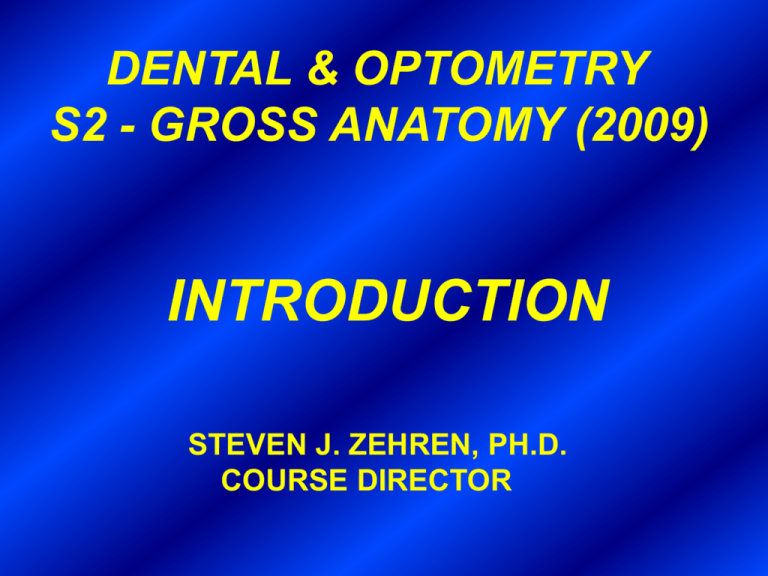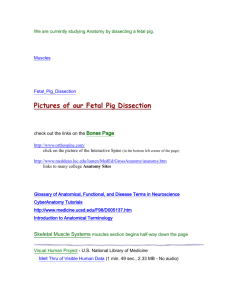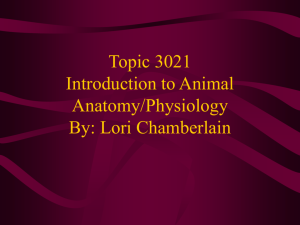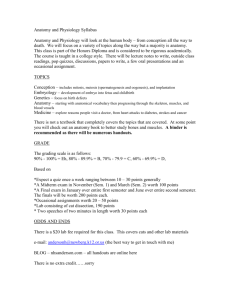Ppts/Introduction to Gross Anatomy Module
advertisement

DENTAL & OPTOMETRY S2 - GROSS ANATOMY (2009) INTRODUCTION STEVEN J. ZEHREN, PH.D. COURSE DIRECTOR TEACHING FACULTY DR. DIANE BIMCZOK DR. GEORGE SALTER DR. FRANK SALTER DR. SHANE TUBBS DR. STEVEN ZEHREN GROSS ANATOMY LABORATORY STAFF MR. VINCE WILLCUTT COURSE SCHEDULE (IN SYLLABUS) BOOKS AND SUPPLIES GROSS ANATOMY TEXTBOOK (REQUIRED) Essential Clinical Anatomy (3rd ed.) by Moore & Agur DISSECTOR (REQUIRED) Grant’s Dissector (14 ed.) by Tank ATLAS (REQUIRED) Atlas of Human Anatomy (4th ed.) by Netter MEDICAL DICTIONARY (RECOMMENDED) Dorland’s Illustrated Medical Dictionary or Stedman’s Medical Dictionary LAB SUPPLIES •Dissection Instruments (2 kits per table) •Surgical Gloves •Lab Coat or Scrub Suit •Safety Glasses COURSE GOAL AND LEARNING OBJECTIVES The principal goal of the course is for students to acquire a sound knowledge of the gross anatomy of the head and neck. APPROACHES USED TO ACHIEVE COURSE GOAL •Lectures •Laboratory Dissection •Case Studies LECTURES •Will provide a thorough, well-organized treatment of the anatomy of a particular region (a list of learning objectives precedes each lecture outline in the syllabus) •Important anatomical facts and concepts will be covered •All lectures are in Room C, and will last ~ 50 minutes LABORATORY ANATOMY LAB STUDENT WAIVER FORM LAB ENTRANCE (G089 VOLKER HALL) CARDKEY 6 1 C H A L K B O A R D SINK 8 SINK TT OO OO LL 16 12 17 13 18 WASTE BB I I NN WASTE 4 9 14 19 5 10 15 20 PROSECTION ROOM WET SOL WASTE 7 3 SINK 11 WASTE 2 WET SOL SINK WET SOL SINK WET SOL SINK CONDUCT IN THE LABORATORY CASE STUDIES (Group Discussions) (Groups A & B) Purpose is to help students understand the relevance of anatomy to their future clinical practice ATTENDANCE POLICY Students are expected to attend ALL lectures, labs and case studies Active participation in the lab (engaging in the dissection process) is ESSENTIAL for every student EXAMS & GRADES EXAM 1 EXAM 2 WRITTEN 64 46 110 + 2 MOCK LAB PRACTICALS LAB 50 50 100 ABSENCE FROM EXAMS GRADING SCALE (%) A B C F = = = = > 90 80 - 89 70 - 79 < 70 COMPETENCY EXAM Students who earn a grade of 60 – 69 in the course will be allowed to take a competency exam. This exam will be comprehensive and will include both a lab and a written component. If a student earns a grade of > 70 on this exam, he/she will receive the lowest possible passing grade for the course (ie, 70 = C). REMEDIATION POLICY In the event that a student receives a grade of F for the course, he/she will be required to take a remedial course in head and neck gross anatomy during the summer. COURSE EVALUATION ANATOMY STUDY TIPS ANATOMY STUDY TIPS •Anatomy is a visual science. Try to visualize your cadaver dissection and use an atlas when studying notes at home. •Try to put the anatomical information you learn in a clinical context (eg, what would be the deficits if this nerve were cut, or this artery ligated?) •Periodically use a systemic approach to studying anatomy (eg, review all of the branches of the trigeminal nerve) •Study with a group (eg, review lab dissections with classmates) •Focus attention on the nervous system •Keep up with dissections and study lecture notes daily COMPUTERIZED INSTRUCTION COURSE WEBSITE http://cellbio.uab.edu/grossanatomy Password: muscle COURSE WEBSITE • POWER POINT PRESENTATIONS • NETTER PLATE NOTES •SAMPLE WRITTEN TEST QUESTIONS • LINKS TO OTHER ANATOMY SITES END




